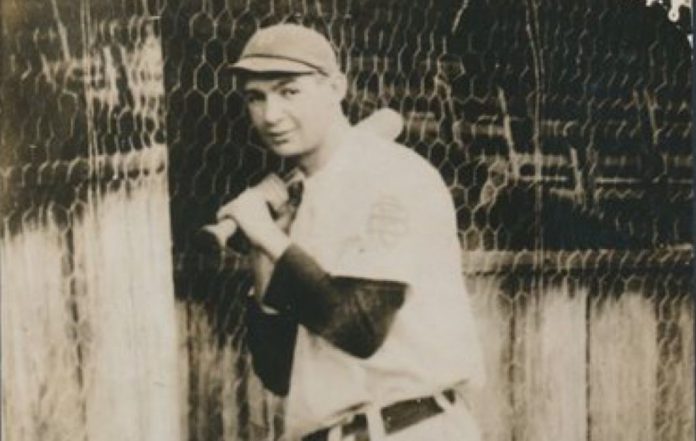During their World Series winning season in 1909, the Pittsburgh Pirates had a 22-year-old rookie second baseman from Kearny, NJ, playing every day alongside the great Honus Wagner. The two bonded quickly and formed a strong double play combo, leading the Pirates to a 110-42 record. Wagner was already an established star, who was still the best player in the league at 35 years old. Miller had just one season of minor league ball prior to his big league debut. Despite the inexperience, he fit in with the Major League players from day one.
Miller was with the Pirates during Spring Training in 1909, trying to win a bench job. Back in the day, the Pirates started their training with numerous intrasquad games. The best players were on a team dubbed the “Regulars”, while the players competing for a bench job played for the “Yanigans”. The term Yanigan has Celtic origins and basically means something that is easily beaten. In baseball terms, it was used for an inexperienced player. Miller was placed on the Yanigans.
After some impressive showings in Spring Training games, Miller was moved over to the Regular team by manager Fred Clarke. He was starting at shortstop as well. Honus Wagner wasn’t with the Pirates during Spring Training of 1909. He had his own basketball team up in Pittsburgh and was getting in shape by playing daily. He didn’t join the Pirates until the very end of the spring before the club left for Cincinnati for the April 14th season opener.
Miller took advantage of Wagner’s absence. By the middle of spring, teammates and newspaper writers were occasionally calling him “Honus the Second”. Miller is known by “Dots” now, but that was a nickname that no one with the team knew about until May. He was going by either John or Jack most of the time in print, with John being his given first name.
There was a popular story that said Wagner mistakenly gave him the nickname when he was asked by a writer which player was the new Miller kid. In his German accent, Wagner responded “Dots Miller”, saying dots instead of “that’s”. It makes the nickname more interesting, but it wasn’t true.
The local writers knew Miller already before the saw Wagner that spring, and the “Dots” nickname was never used until the team played at the Baker Bowl in Philadelphia. Miller’s family and friends made the trip from Kearny and everyone was calling him Dots. Word got around and one writer looked into the name. It turns out that Miller had that nickname already for about 20 years. As a child, he used to grab things and say “Dots mine”. So it turns out that the German accent and “that’s vs dots” were true, but it was Miller himself as a small child who earned his nickname.
The “new” nickname caught on, but Miller was already making a name for himself by the time his family and friends showed up. It took a little bit of bad luck from another player to get him a spot.
When Wagner joined the Pirates, Miller was going to take up a utility role. The Pirates had Ed Abbaticchio at second base and he was a favorite of owner Barney Dreyfuss, so much so that they gave up three solid players to acquire him after he sat out the entire 1905 season. It was an odd man-crush by Dreyfuss because Abbaticchio really wasn’t anything special. I’ll note that Dreyfuss went on record saying that the being the first Italian-American star (his words, not mine) meant that Abbaticchio could help draw fans from that population.
It took a little bad luck for Abbaticchio to get Miller in the lineup, and also convince Dreyfuss that his star player shouldn’t be in the lineup every day. Abbaticchio started the first four games of the season at second base and went 0-for-15 with six errors, while the Pirates had a 1-3 record. That was bad enough to give the young Miller a start. One start turned into two, three and eventually the final 150 games of the season. Miller took second base and refused to give it up. In fact, he played every single inning from the start of the fifth game of the season until the end of the World Series.

Keeping in mind that this was the middle of the deadball era when you’re looking at the stats here. In 151 games (he pinch-hit during the third game of the season), Miller hit .279/.329/.396, with 71 runs scored, 31 doubles, 13 triples, 87 RBIs and 222 total bases. He batted .250 in seven World Series games and drove in four runs.
Those numbers compared to now really don’t stand out, except the triples. However, Miller had the seventh highest slugging percentage in the National League that season. He ranked ninth in hits (156), fifth in total bases, third in doubles, fourth in triples and third in RBIs. His 47 extra-base hits ranked third in the league. He also dropped down 29 sacrifice bunts, eighth most in the league.
On defense, he led the NL with a .953 fielding percentage at second base and he compiled the most assists (426) at his position.
Using today’s metrics, he had a 4.6 WAR for the season, which was eighth best among NL position players. Honus Wagner led the way with a 9.2 WAR.
Miller joined the Pirates in March of 1909 hoping for a bench job, back when teams carried a smaller roster than today. He earned that job with a strong spring, then when given the opportunity, he took the starting second base job and was one of the best players in the National League that year. It was the start of a 12-year career in the majors, which included a year off in 1918 to serve in WWI.
Here are the previous articles in this series:



